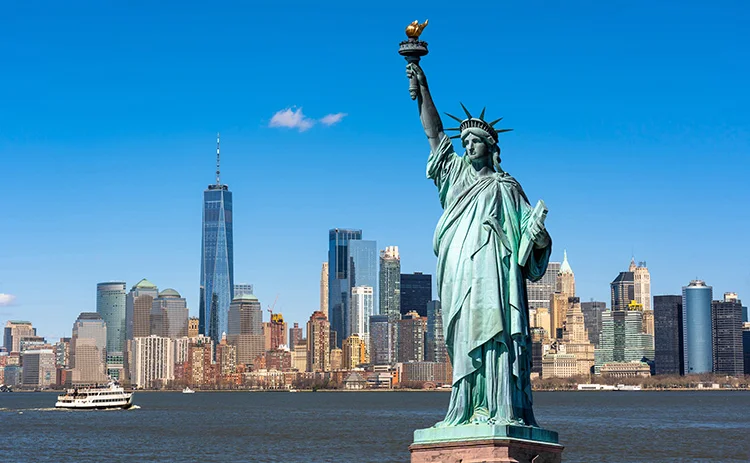Introduction
The Statue of Liberty, one of the most famous landmarks in the United States of America, stands tall as a universal symbol of freedom, democracy, and hope. Located on Liberty Island in New York Harbor, the statue welcomes millions of visitors each year who come to admire its beauty, history, and cultural significance. Designated as a UNESCO World Heritage Site, the Statue of Liberty is not only a masterpiece of art and engineering but also a powerful emblem of America’s enduring values.
History of the Statue of Liberty
The Statue of Liberty was a gift from France to the United States in 1886 to celebrate the friendship between the two nations and commemorate the centennial of American independence. Designed by the French sculptor Frédéric Auguste Bartholdi and built with the assistance of Gustave Eiffel, the statue took nearly a decade to complete.
On October 28, 1886, the Statue of Liberty was officially dedicated in a grand ceremony attended by thousands of people, including President Grover Cleveland. Over the years, it has become a beacon of hope for immigrants arriving in the United States, symbolizing a new beginning and the pursuit of the American Dream.
Design and Symbolism
The Statue of Liberty is a neoclassical sculpture standing 305 feet (93 meters) tall from the ground to the tip of her torch. Made of copper, the statue has developed a green patina over time due to natural oxidation.
Key symbolic features include:
-
Torch: Represents enlightenment and the path to freedom.
-
Crown with Seven Spikes: Symbolizes the seven continents and seven seas, highlighting liberty’s universal reach.
-
Tablet: Inscribed with the date July 4, 1776, representing American independence.
-
Broken Chains at Her Feet: Signify the end of oppression and tyranny.
Every detail of the statue carries a message of hope, liberty, and equality, making it a timeless icon of human rights and freedom.
 Visiting the Statue of Liberty
Visiting the Statue of Liberty
The Statue of Liberty is one of the most visited tourist attractions in the USA. To reach the monument, visitors must take a ferry service operated by Statue City Cruises from either Battery Park in Manhattan, New York, or Liberty State Park in Jersey City, New Jersey.
Things to Do When Visiting:
-
Liberty Island: Explore the grounds surrounding the statue, enjoy breathtaking views of the New York City skyline, and take photos of Lady Liberty up close.
-
Statue of Liberty Museum: Opened in 2019, the museum showcases the history, construction, and symbolism of the statue. The highlight is the original torch, displayed for visitors to admire.
-
Pedestal Access: Visitors can climb up to the pedestal for stunning views of New York Harbor.
-
Crown Access: With special tickets, adventurous visitors can climb 354 steps to reach the crown for a once-in-a-lifetime view.
-
Ellis Island: Often included in the same trip, Ellis Island is a historic immigration station where millions of immigrants entered the United States between 1892 and 1954.
Ticket Information
Tickets for visiting the Statue of Liberty are available online through Statue City Cruises. Prices vary depending on access levels:
-
Grounds Only Ticket: Includes ferry ride and access to Liberty and Ellis Island.
-
Pedestal Ticket: Includes access to the pedestal platform.
-
Crown Ticket: Includes access to the crown (must be reserved well in advance).
Children under 4 are free, and discounts are available for seniors and children under 13.
Best Time to Visit
The Statue of Liberty is open year-round, except on Thanksgiving Day and Christmas Day. The best times to visit are:
-
Spring (April – June): Mild weather and fewer crowds.
-
Fall (September – November): Pleasant temperatures and beautiful views.
-
Morning Hours: Early ferries are less crowded, offering a more peaceful experience.
Tips for Visitors
-
Book tickets in advance, especially for pedestal and crown access.
-
Wear comfortable shoes, as visiting involves a lot of walking and climbing.
-
Allow at least 4–5 hours to fully experience Liberty Island and Ellis Island.
-
Bring water, snacks, and a camera to capture the unforgettable sights.
-
Security checks are strict, so avoid carrying large bags or restricted items.
The Statue of Liberty’s Cultural Impact
The Statue of Liberty has appeared in countless films, books, and artworks, symbolizing the American spirit. It is also a popular subject for souvenirs, postcards, and photography. Beyond its cultural presence, it continues to inspire people from around the world who see it as a shining beacon of hope, opportunity, and freedom.
For millions of immigrants who arrived by ship in the late 19th and early 20th centuries, the first glimpse of Lady Liberty signaled that they had reached a land of new opportunities. Even today, she stands as a reminder of America’s welcoming spirit.
Quick Facts About the Statue of Liberty
-
Official Name: Liberty Enlightening the World
-
Height: 305 feet (93 meters)
-
Weight: 225 tons
-
Location: Liberty Island, New York Harbor
-
Dedicated: October 28, 1886
-
Architect: Frédéric Auguste Bartholdi
-
Engineer: Gustave Eiffel
Conclusion
The Statue of Liberty in the USA is more than just a monument—it is a powerful symbol of freedom, democracy, and hope for people across the globe. Whether you are a history lover, a traveler seeking iconic landmarks, or someone who simply wants to experience the essence of America, a visit to the Statue of Liberty is an unforgettable journey.
Standing tall in New York Harbor, she continues to remind the world of the values of liberty, justice, and equality. A trip to the Statue of Liberty is not just a sightseeing adventure—it is an opportunity to connect with history, culture, and the enduring human spirit.


You must be logged in to post a comment.